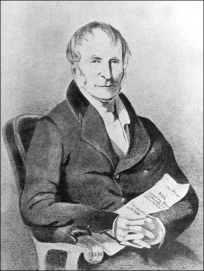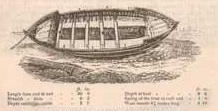In September 2008 an exceptionally rare Gold Medal produced by the Royal National Institute for the Preservation of Life from Shipwreck was sold at auction for £3,200. The medal, with its unique pendant in the shape of a lifeboat, was awarded in 1853 to George Palmer, who had worked tirelessly for the institution for over a quarter of a century. Palmer’s achievements, especially his design of a lifeboat, have rightly secured his place in the annals of seafaring history, but his parliamentary career remains somewhat overlooked, even though it was his status as an MP that allowed him to produce vital legislation which improved safety at sea.
Palmer was only fourteen years old when he joined the navy of the East India Company. His early, often dangerous, experiences at sea left an indelible mark upon him: a narrow escape from drowning near Macao in 1788 persuaded him that a boat’s equilibrium was paramount to its safety, a conviction that shaped his future thinking on timber vessels. He retired from the navy at the turn of the century due to ill-health and went on to secure a small fortune as an East India merchant, but maritime safety remained his foremost concern.
In 1826 he began working with the National Institution for the Preservation of Life from Shipwreck (known as the Royal National Lifeboat Institution after 1854), an organisation he went on to serve as deputy chairman for twenty five years. In 1828 his design of a lifeboat – built as a whale-boat, sharp at both ends, using air-cases for buoyancy – was officially adopted by the institution. By 1844 lifeboats based on his work had been placed at over 30 coastal locations around the British Isles. Significantly, Palmer, as a Member of Parliament, chaired the 1843 select committee on shipwrecks, in which he submitted his own lifeboat design, thus ensuring the widest and most influential audience for his work.
Palmer’s status as an MP undoubtedly helped him to achieve his ambition to improve safety at sea. First elected as a Conservative for Essex South at an 1836 by-election, he made his mark in his first full Parliament through his crusade to address the loss of life caused by shipwrecks. In April 1839 he successfully moved for a select committee to consider the regulation of timber trading ships crossing the Atlantic Ocean. The report of the inquiry, which he skilfully chaired, recommended that timber-laden vessels between the United States and Britain be barred from carrying deck-loads. After making a compelling case for the legislation in the Commons chamber, it arrived on the statute book as the 1839 Timber Ships, British North America Act. He followed this up with what became his main legislative triumph: the 1845 Timber Ships Act which extended and settled the law prohibiting timber ships from carrying deck cargoes.
In many ways Palmer, the former sailor and merchant dedicated to maritime issues, was an unlikely fit for Essex South, an overwhelmingly rural constituency where the key issues were maintenance of agricultural protection and repeal of the much-detested malt tax. Yet Palmer, showing political savvy, reinvented himself as a ‘friend of the plough, the loom and the sail’, and promised his constituents that he would be unwavering in his defence of the corn laws. True to his word, he consistently voted against free trade proposals, and when Peel’s decision to support repeal of the corn laws became public, he pulled no punches in his denunciation of the prime minister, declaring to a packed Commons that Peel ‘stood in the light of Ahab’s prophets of old. He would deceive himself, and bring down destruction upon a devoted people’.
With his health declining, Palmer retired from the Commons at the 1847 dissolution, but continued to devote his energies to the Shipwreck Institution. He was instrumental in securing the services of the Duke of Northumberland as its president and continued to chair meetings until his retirement in February 1853, when he was awarded the gold medal of the institution. He died the following month. In 1854 his model of lifeboat was replaced by the ‘self-righting’ boat, based on an original design by James Beeching.
Palmer’s tenure in the Victorian Commons underlines how a politician could use their parliamentary status to promote humanitarian causes close to their heart. By pulling the levers of power – in his case through the adroit management of select committees – Palmer was able to achieve his legislative goals and leave a lasting legacy for maritime safety.
For details of how to access Palmer’s full History of Parliament biography from our preview site, please see here.



